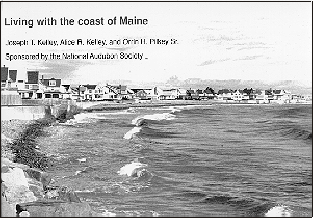DACF Home → Bureaus & Programs → Maine Geological Survey → Explore Maine Geology → Coastal Marine Geology → Living with the Coast of Maine
 |
Living with the Coast of Maineby Joseph T. Kelley, Alice R. Kelley, and Orrin H. Pilkey, Sr. 174 p., 118 figures, 3 appendixes |
This book is one in a series, Living with the Shore, published by Duke University Press. This book is intended to be read by non-scientists who have an interest in the Maine coast, particularly as it is suited for coastal development of homes. Coastal geology and hazards are discussed in relation to factors of sea-level rise, storms, flooding, and erosion. Selecting a safe site and building design are presented in the form of maps, photographs, and illustrations. Coastal engineering of seawalls and jetties is presented from a geological perspective. Sources of additional information are listed for those seeking more detail.
Contents:
1. A coastal perspective
- History of development
- Storms
- Pollution
- Environmental destruction
- Reduced public access
- Coastal calamities: a stormy past
2. Maine's changing coastline
- Geologic history of the Maine coast
- Bedrock formation
- Most recent Ice Age
- Postglacial drowning of coastal Maine
- Withdrawal of the sea and emergence of the land
- Modern drowning of the coast
- The origin of Maine's large sand beaches and muddy estuaries
- Saco Bay -- large sand beaches
- Casco Bay -- large muddy estuaries
- Beaches: the dynamic equilibrium
- How does the beach respond to a storm?
- How does the beach widen?
- Where does beach sand come from?
- Why do beaches erode?
- If most shorelines are eroding, what is the long-range future of beach development?
- What can I do about my eroding beach?
3. Man and the shoreline
- Shoreline engineering: stabilizing the unstable
- Beach replenishment
- Groins and jetties
- Other structures
- A philosophy of shoreline conservation: "We have met the enemy and he is us"
- Truths of the shoreline
- Questions to ask if shoreline engineering is proposed
- The solutions
4. Selecting a site on the Maine coast
- Stability indicators: some clues for the wise
- Vegetation
- Terrain, elevation, bedrock
- Coastal environments: boundaries of activity
- The beach
- Frontal dunes
- Back dune fields
- Overwash fans and tidal inlets
- Maritime forests
- Salt and freshwater marshes and bogs
- Upland bluffs
- Site safety: rules for survival
- Summary checklist for site safety evaluation
- Analysis of specific coastal regions "safe," "caution," and"danger" zones
- Arcuate embayments
- Indented shoreline compartment
- Island-bay complex
- Cliffed shoreline compartment
5. Coastal land use and the law in Maine
- The Alteration of Coastal Wetlands Act and its rules
- Mandatory Shoreline Zoning Act
- The National Flood Insurance Program
- Some flood insurance facts
- Coastal Barrier Resources Act
- Other laws and policies
6. Building or buying a house near the beach
- Coastal realty versus coastal reality
- The structure: concept of balanced risk
- Coastal forces: design requirements
- Storm surge
- Storm waves
- Battering by debris
- Barometric pressure change
- House selection
- Keeping dry: building on the sand -- pole or stilt houses
- Building on rocks
- An existing house: what to look for
- Geographic location
- How well built is the house?
- What can be done to improve an existing house?
- Mobile homes: limiting their mobility
- An unending game: only the players change
Last updated on December 10, 2009
